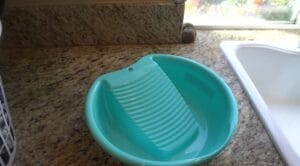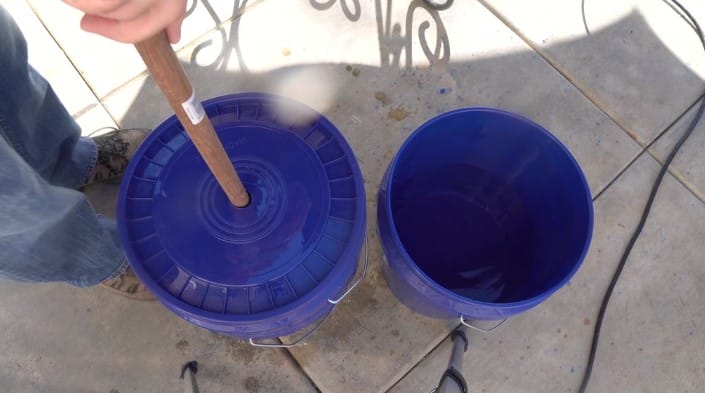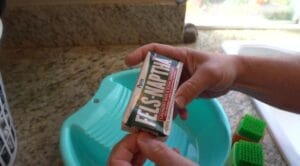 The first method is the Wonderwash Non-electric Portable Compact Mini Washing Machine. These are popular with overlanders, off-grid livers, even small apartment, and dorm room dwellers. It’s incredibly simple to use and designed for this specific purpose. I will put a link to it in the comments below. https://amzn.to/3AAoAhR To use it, you simply unclasp and remove the top. Place up to 5 pounds of clothes in it. Add about a tablespoon of detergent. Fill with water to the ridge you see on the outside. Then put the lid on and turn clockwise to fasten and clasp down the lid. Now, you simply crank the handle for two to three minutes. You can rock it too. You are agitating the water around the clothes. To drain it, attach the hose to the bottom. It will instantly start to drain. It’s a watertight container, so it will drain much faster if you also remove the lid on the top. Remove the hose when it is drained. It drains from the bottom, so it is unnecessary to angle it for proper draining. Fill the tank again with fresh water for your rinse cycle, then repeat the agitation by cranking for another two to three minutes. Drain again, and your clothes are ready to be wrung by hand and hung on a line to dry.
This unit only weighs five pounds, and it is very solidly built. You can use it for years and years, and it does a great job. If you have hand washables, it is extra gentle on them. We have used this in the past, and we can definitely see its utility for anyone off the grid. One drawback is that it does not drain the clothes off the water. There is no spin or ringing cycle for it. So, when you take your clothes out, they will still need to be wrung dry and hung out to air dry.
Washboard Basin & Fels Naptha Laundry Soap
The first method is the Wonderwash Non-electric Portable Compact Mini Washing Machine. These are popular with overlanders, off-grid livers, even small apartment, and dorm room dwellers. It’s incredibly simple to use and designed for this specific purpose. I will put a link to it in the comments below. https://amzn.to/3AAoAhR To use it, you simply unclasp and remove the top. Place up to 5 pounds of clothes in it. Add about a tablespoon of detergent. Fill with water to the ridge you see on the outside. Then put the lid on and turn clockwise to fasten and clasp down the lid. Now, you simply crank the handle for two to three minutes. You can rock it too. You are agitating the water around the clothes. To drain it, attach the hose to the bottom. It will instantly start to drain. It’s a watertight container, so it will drain much faster if you also remove the lid on the top. Remove the hose when it is drained. It drains from the bottom, so it is unnecessary to angle it for proper draining. Fill the tank again with fresh water for your rinse cycle, then repeat the agitation by cranking for another two to three minutes. Drain again, and your clothes are ready to be wrung by hand and hung on a line to dry.
This unit only weighs five pounds, and it is very solidly built. You can use it for years and years, and it does a great job. If you have hand washables, it is extra gentle on them. We have used this in the past, and we can definitely see its utility for anyone off the grid. One drawback is that it does not drain the clothes off the water. There is no spin or ringing cycle for it. So, when you take your clothes out, they will still need to be wrung dry and hung out to air dry.
Washboard Basin & Fels Naptha Laundry Soap
 The second method is the old-fashioned washboard basin and a laundry bar. We will link to the ones we are using in the comments below. This is the method that has been used for hundreds of years. It’s one step up from washing your clothes in a creek and beating them on a rock, and it takes a lot longer to process a five-pound load, but it will never fail you. Simply rub the soap bar over the clothes and agitate against the washboard. You can use a laundry brush for spot cleaning areas with heavy dirt, the pits of shirts, or any location that has some staining. We picked up a two-pack of these silicone laundry brushes pretty cheaply, and we use these for day-to-day cleaning with my laundry machine. When the clothes are clean, rinse them free of soap. Wring them and hang them to dry.
There are many kinds of soaps and detergents. Fels-Naptha has been around for over 100 years, and one bar will go a long way. If you would like for me to do a video on using this bar and a few other ingredients to make a year’s supply of your own laundry detergent, let me know in the comments below. We are considering doing this because we realized in the making of this video that we are spending almost three hundred dollars a year on laundry detergent when we could make the same amount at home for under twenty dollars. Again, if you would like to see me do this, give this blog a thumbs up and leave a comment below.
Homemade Agitator
The second method is the old-fashioned washboard basin and a laundry bar. We will link to the ones we are using in the comments below. This is the method that has been used for hundreds of years. It’s one step up from washing your clothes in a creek and beating them on a rock, and it takes a lot longer to process a five-pound load, but it will never fail you. Simply rub the soap bar over the clothes and agitate against the washboard. You can use a laundry brush for spot cleaning areas with heavy dirt, the pits of shirts, or any location that has some staining. We picked up a two-pack of these silicone laundry brushes pretty cheaply, and we use these for day-to-day cleaning with my laundry machine. When the clothes are clean, rinse them free of soap. Wring them and hang them to dry.
There are many kinds of soaps and detergents. Fels-Naptha has been around for over 100 years, and one bar will go a long way. If you would like for me to do a video on using this bar and a few other ingredients to make a year’s supply of your own laundry detergent, let me know in the comments below. We are considering doing this because we realized in the making of this video that we are spending almost three hundred dollars a year on laundry detergent when we could make the same amount at home for under twenty dollars. Again, if you would like to see me do this, give this blog a thumbs up and leave a comment below.
Homemade Agitator
 The homemade agitator takes a little construction, but you can easily make one and take it camping or over landing. Basically, you just need a standard 5-gallon bucket with a lid and a plunger. While you could do all this with just one 5-gallon bucket, we will make a three-bucket version. As you will see from the demonstration, this makes rinsing and wringing your clothes easier. To start, drill several holes around the plunger. This will allow the water to flow around the plunger as you work it up and down in the system. Drill a hole large enough for the plunger’s handle to go through on the center of the lid. On a second bucket, we drill several holes around it and in the bottom. This will allow me to remove the clothes from the primary washing bucket easily. This strainer and bucket system has other uses for you, as well. We will use this system to make compost tea at a later date. For now, though, it is still time to do laundry. Place your strainer bucket in the bucket you will use for washing. Place your load of laundry in the bucket. Then, add water and a small amount of detergent. Put the lid on and agitate the wash by working the handle up and down. The plunging action and the water moving through the plunger will agitate the water around your clothes. You can use hotter water and agitate for longer for heavily stained clothes.
When your laundry is clean, remove the strainer bucket. We can use the weight of the washing bucket to press out some of the water. This is where the wringing action with this method is superior. Gravity and my weight presses out most of the water in the clothes. This method is equivalent to wringing the clothes out. Then, we can take the strainer bucket and place it in a bucket full of clean rinse water. Using the same lid and plunger, we can agitate it again for a few minutes and rinse the detergent out. Removing the strainer bucket, we can twist it to let some water fall out and then repeat the weight method to press the water out. Now, we simply have to hand wring a little bit and hang the clothes to dry. Depending upon the detergents you use, the water can be dumped out and will not kill your plants.
This method takes a little more construction with a drill and a few bits but once constructed, this setup will allow you to process several loads quickly. This can easily do more than the Wonderwash, though the Wonderwash is more convenient and requires no construction on your part. It took me about 5-minutes to make this three bucket wash system, from start to finish. You could easily make several for your mutual assistance group in under an hour.
Detergent
The homemade agitator takes a little construction, but you can easily make one and take it camping or over landing. Basically, you just need a standard 5-gallon bucket with a lid and a plunger. While you could do all this with just one 5-gallon bucket, we will make a three-bucket version. As you will see from the demonstration, this makes rinsing and wringing your clothes easier. To start, drill several holes around the plunger. This will allow the water to flow around the plunger as you work it up and down in the system. Drill a hole large enough for the plunger’s handle to go through on the center of the lid. On a second bucket, we drill several holes around it and in the bottom. This will allow me to remove the clothes from the primary washing bucket easily. This strainer and bucket system has other uses for you, as well. We will use this system to make compost tea at a later date. For now, though, it is still time to do laundry. Place your strainer bucket in the bucket you will use for washing. Place your load of laundry in the bucket. Then, add water and a small amount of detergent. Put the lid on and agitate the wash by working the handle up and down. The plunging action and the water moving through the plunger will agitate the water around your clothes. You can use hotter water and agitate for longer for heavily stained clothes.
When your laundry is clean, remove the strainer bucket. We can use the weight of the washing bucket to press out some of the water. This is where the wringing action with this method is superior. Gravity and my weight presses out most of the water in the clothes. This method is equivalent to wringing the clothes out. Then, we can take the strainer bucket and place it in a bucket full of clean rinse water. Using the same lid and plunger, we can agitate it again for a few minutes and rinse the detergent out. Removing the strainer bucket, we can twist it to let some water fall out and then repeat the weight method to press the water out. Now, we simply have to hand wring a little bit and hang the clothes to dry. Depending upon the detergents you use, the water can be dumped out and will not kill your plants.
This method takes a little more construction with a drill and a few bits but once constructed, this setup will allow you to process several loads quickly. This can easily do more than the Wonderwash, though the Wonderwash is more convenient and requires no construction on your part. It took me about 5-minutes to make this three bucket wash system, from start to finish. You could easily make several for your mutual assistance group in under an hour.
Detergent
 When it comes to detergent, you could use soap nuts. They aren’t nuts. They are a type of berry related to the lychee berry. They contain a natural cleaning agent called Saponin. The only problem is the tree grows in the Himalayas, so they wouldn’t be available to most people after a grid-down situation. Fortunately, more than 100 plants contain some level of saponins. Though in smaller concentrations than in the soap nut, you could make use of the saponins in Mojave yucca, horse chestnuts, or the rhizome of the plant soapwort.
Alternately, you can create your own detergents in abundance with some olive oil soap, baking soda, super washing soda, borax, or Epsom salts. It’s a little more caustic than plant-derived saponins, but all the substances are found in nature. Concentrations of them can be harmful to fish, but plants have few if any problems with your used detergent water. Again, if you would like to see a future blog on making your own laundry detergent, give this video a thumbs-up and let me know in the comments below.
Conclusion
Keeping clean after a disaster is essential but often overlooked. While you could go a year or more without bathing, your risk of developing skin rashes, infections, eczema, or other complications is far greater. Simply having a clean set of clothes and a clean body can give you a little psychological boost, so get a method to do laundry in your prepping supplies. We’ll link to our City Prepping soap-making recipe here. Between that information and this information, you will be cleaner, healthier, and happier after any disaster, just maybe not as happy still having to do laundry.
Have you used one of these methods to do laundry or another method? Let us know in the comments below. We try to read many of the comments and respond to them when we can, and that’s typically within the first hour of releasing a blog. Please consider subscribing to the channel if you’d like to be notified when we release a video and give this blog a thumb-up to help the channel grow.
As always, stay safe out there.
Plunger – https://amzn.to/3IHiSxD
WonderWash Non-electric Portable Washing Machine – https://amzn.to/3KJxcYk
Washboard Basin – https://amzn.to/3KJcOpV
Fels-Naptha Laundry Soap – https://amzn.to/3nV7qWX
2 Pack Silicone Laundry Scrub Brush – https://amzn.to/3ICuPV7
When it comes to detergent, you could use soap nuts. They aren’t nuts. They are a type of berry related to the lychee berry. They contain a natural cleaning agent called Saponin. The only problem is the tree grows in the Himalayas, so they wouldn’t be available to most people after a grid-down situation. Fortunately, more than 100 plants contain some level of saponins. Though in smaller concentrations than in the soap nut, you could make use of the saponins in Mojave yucca, horse chestnuts, or the rhizome of the plant soapwort.
Alternately, you can create your own detergents in abundance with some olive oil soap, baking soda, super washing soda, borax, or Epsom salts. It’s a little more caustic than plant-derived saponins, but all the substances are found in nature. Concentrations of them can be harmful to fish, but plants have few if any problems with your used detergent water. Again, if you would like to see a future blog on making your own laundry detergent, give this video a thumbs-up and let me know in the comments below.
Conclusion
Keeping clean after a disaster is essential but often overlooked. While you could go a year or more without bathing, your risk of developing skin rashes, infections, eczema, or other complications is far greater. Simply having a clean set of clothes and a clean body can give you a little psychological boost, so get a method to do laundry in your prepping supplies. We’ll link to our City Prepping soap-making recipe here. Between that information and this information, you will be cleaner, healthier, and happier after any disaster, just maybe not as happy still having to do laundry.
Have you used one of these methods to do laundry or another method? Let us know in the comments below. We try to read many of the comments and respond to them when we can, and that’s typically within the first hour of releasing a blog. Please consider subscribing to the channel if you’d like to be notified when we release a video and give this blog a thumb-up to help the channel grow.
As always, stay safe out there.
Plunger – https://amzn.to/3IHiSxD
WonderWash Non-electric Portable Washing Machine – https://amzn.to/3KJxcYk
Washboard Basin – https://amzn.to/3KJcOpV
Fels-Naptha Laundry Soap – https://amzn.to/3nV7qWX
2 Pack Silicone Laundry Scrub Brush – https://amzn.to/3ICuPV7 
